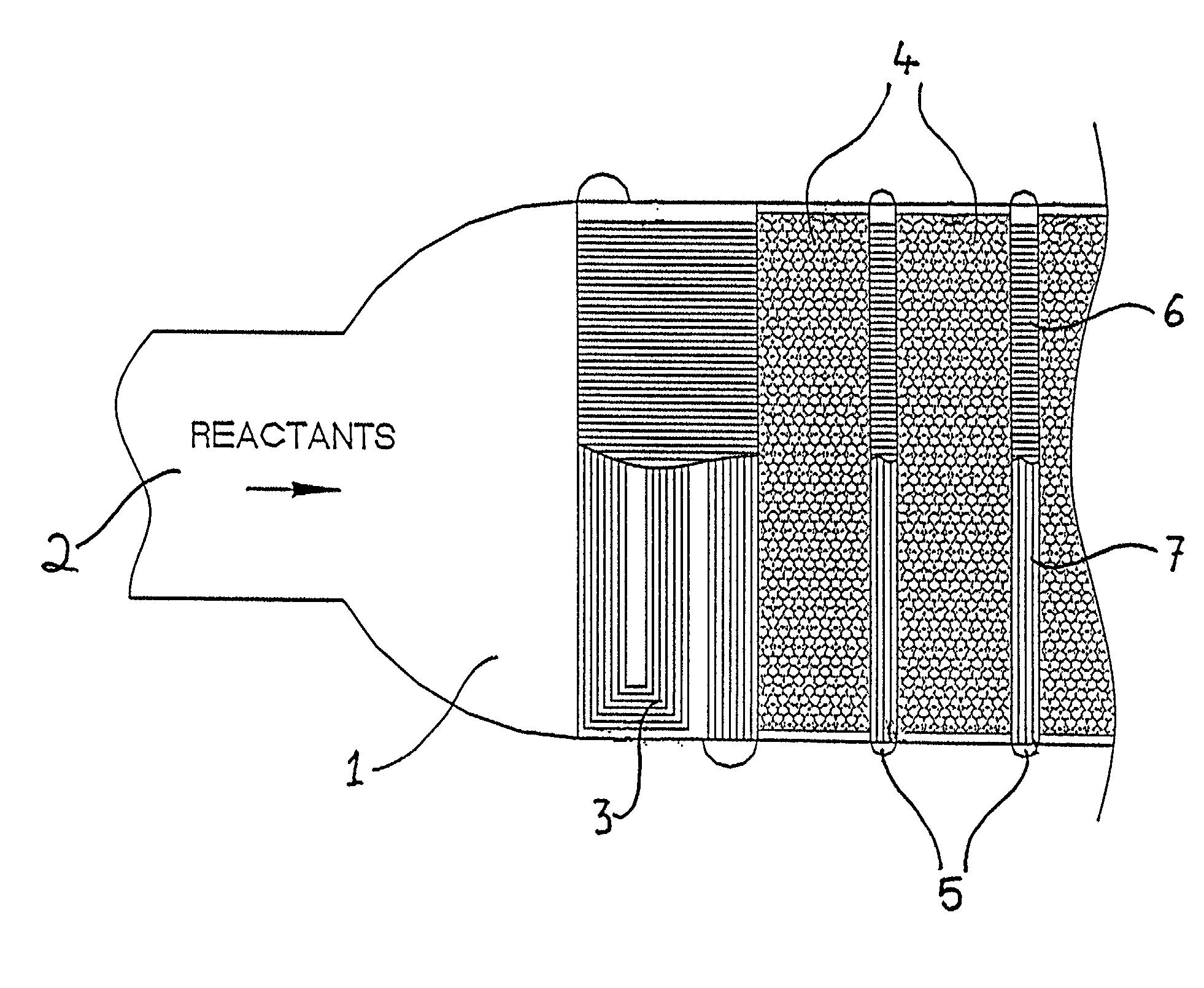The cooling effects for endothermic reactions generally adversely affect the rate of reaction and the corresponding parameters such as conversion and selectivity of the products from the reaction.
The uncontrolled heating of exothermic reactions generally leads to damage to the associated apparatus as the temperature can rise to a
very high level.
The reaction in such a case may become uncontrolled (so-called “run away reaction”) and lead to unwanted by-products and undesired effects, such as deactivation of a process catalyst.
Furthermore, whilst an ideal catalyst does not theoretically participate in a reaction in reality many catalysts become degraded or poisoned as the reaction progresses and on an
industrial scale the costs associated with
catalyst regeneration or replacement represent a significant burden.
However, particularly for highly exothermic reactions, such an approach has not been found to be ideal since the
packed bed often develops heat gradients, e.g. the catalyst
bed will be cooler at its areas of contact with the said tubes or plates and hotter within its depth remote from said tubes or plates, permitting formation of hot spots or moving hot fronts leading to variations in reaction progress within the bed as a whole.
Typical approaches to such problems include the addition of quench gas to cool the
system, but this leads to a loss in efficiency and may thus have an
adverse effect on yield.
A further approach is to introduce a heat exchange step between adiabatic beds, which may involve the incorporation of heat exchangers into the reactor, but this leads to both design and operational problems due to the bulk of tubular designs and a lack of
differential pressure containment with plate exchangers.
There are also problems with reactant re-distribution.
Alternatively, the reactants may be removed from the reactor for intermediate heat exchange e.g. cooling, but this also has an
impact on
plant design and
process operation due to the additional expensive
piping, and distribution problems with each extraction and re-injection.
Thus this is not practical to do more than once or twice in any particular
system.
A further approach is to adopt continuous heat exchange by packing tubes or plates into the catalyst bed, but this leads to design inflexibility, additional expense, uneven packing of catalyst, and of course difficulty in replacing or regenerating the catalyst.
Alternatively, heat exchange tubes, plates and passages of the reactor may be coated with catalyst, but here again this leads to an inflexible design, difficulties in applying catalyst reliably and restrictions upon available superficial catalyst surface area.
Also with this approach, there are obvious difficulties in replacing or regenerating the catalyst.
Fluidised bed reactors represent another potential solution to these problems, but these may not be ideally suited to all or certain reaction systems.
The possibility of using an
inert or
reactive diluent to
ballast the temperature of reactants in adiabatic beds has been considered but such a
diluent must be heated, cooled, and pumped which places extra energy demands on the process and moreover, may also interfere with the intended reaction by presenting a
diffusion barrier to reactants.
The plates are joined, such as by
welding, along these smooth edges and hence the integrity of the seal of the channels formed by the corrugations in adjacent plates is not ideal, particularly where a large pressure differential exists between the heat exchange flow channels and the reaction flow channels since this will tend to urge the adjacent plates apart.
This arrangement will thus place unnecessary constraints on parameters of the reaction, namely the relationship between the pressure of the heat exchanging fluid and that of the reactant gas.
Thus there remains the possibility of hot spots and less than satisfactory
thermal control in such large catalytic reactor volumes.
Unfortunately, both these parameters are
process requirements and hence cannot be changed in order to improve the
heat transfer coefficient in the
packed bed, and hence in the reaction cells described in U.S. Pat. No. 5,073,352.
Additionally, it is difficult to move catalyst between narrow gaps or tubes, imposing limits on the dimensions of gaps or tubes through which catalyst is designed to flow.
Thus reactors of the known types according to the existing art have many significant limitations imposed on the
heat transfer capability.
Generally both an external jacket and internal coil afford only a limited
heat transfer surface.
External heat transfer requires pumped circulation, and imperfect mixing within the reactor can result in significant deviation between the composition of the fluid circulated through the external
heat exchanger and bulk mixed
fluid composition in the reactor.
This latter problem is most likely to arise whilst a reactant is being added to the reactor.
Efforts to ensure good mixing frequently meet with unsatisfactory results, and
reaction conditions often need to be less than optimal to allow for variations in reactant concentration.
As a result of the shortcomings outlined above, some reactions are carried out with a reactor
residence time that is much longer than needed by the reaction
kinetics alone, due to poor heat and / or
mass transfer, with consequent loss of reaction selectivity.
Further, CSTRs are characterised by substantially complete back mixing of reaction products with reactant; this can inhibit the
reaction rate, and can also result in product loss through unwanted further reactions.
 Login to View More
Login to View More 


